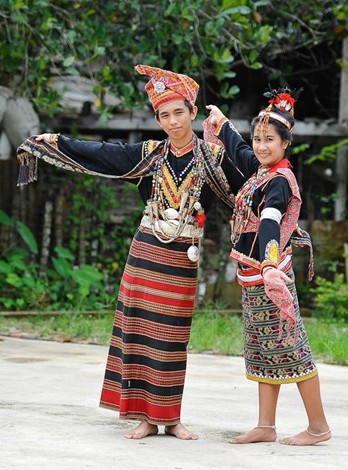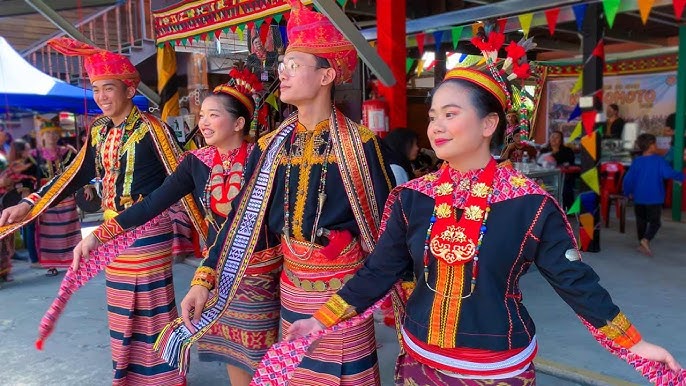ARTS AND CULTURE INFORMATION GATEWAY
Immerse yourself in the colorful world of art and culture! From traditional heritage to contemporary works, discover uniqueness that reflects the nation's identity and identity
SUMAYAU
Picture
3
Video
No record
Today's Visitor
26
Number of Visitors
910
Introduction and history
Sumayau, also known as Madsayau, is a traditional dance of the Kadazan-Dusun ethnic group, specifically from the Dusun Lotud or Suang Lotud tribe in the Tuaran District of Sabah. This dance carries deep spiritual and cultural significance, as it is an integral part of the ritual ceremonies and beliefs of the Dusun Lotud community. The word “Sumayau” means "to dance," while its root term, “Madsayau,” also translates to "dancing" or "performing a dance."
Traditionally, Sumayau is not performed for entertainment or festivities. Instead, it is a sacred ceremonial dance that forms an integral part of the Rumaha ritual—a ceremony dedicated to venerating skulls—and the Magahau ritual, which involves the worship of the spirits associated with Gusi-Gusi or Tajau (ceremonial jars). Both rituals hold profound significance in the customary practices and beliefs of the Dusun Lotud community, typically lasting between five and seven days. The dance is performed to honour the spirits or souls of the deceased, who are believed to bring prosperity to the community. As such, Sumayau also serves as an expression of gratitude and respect toward departed family members.
Nevertheless, some members of the Dusun Lotud regard Sumayau as an important cultural performance that embodies their inherited arts and traditions. While it is no longer confined solely to ritual ceremonies, it is now performed at cultural festivals such as the Kaamatan Festival to celebrate and preserve their heritage. This broader context allows the traditional practices of the Dusun Lotud people to gain wider recognition—not only among other ethnic groups but also within Malaysia’s multicultural society. Consequently, the dance has evolved beyond its original ritualistic purpose and is now a symbol of cultural appreciation and pride.
In the Sumayau performance, dancers wear traditional attire, typically consisting of dark or black garments accented with embroidery in gold and bright red or reddish-brown tones. The men’s traditional outfit, known as Rinapa’an or Kirinapa’an do Suang Lotud, includes a set of clothing referred to as Sukob, which features intricate motif designs on the sleeves and chest. This attire is paired with the Mugah, a handwoven sarong. For the headpiece, male dancers wear a Sundi, a woven cloth styled into a headdress. Completing the ensemble is the Sandai, a handwoven sash draped diagonally across the body, adding a distinctive and elegant touch to the attire.
Next, the mandatory accessories worn by male dancers consist of six types:
1. Karoh – A long necklace made from strands of beads, shells, and wood.
2. Bubu Tulan – A belt crafted from silver.
3. Botungkat – A belt made of silver-based coins.
4. Supuh – A spherical silver ornament worn on the left side of the Bubu Tulan.
5. Tatarapan – A kris (traditional dagger) made of silver.
6. Simpai – A bracelet made of silver.
On the other hand, female dancers wear an outfit known as Rinapa’an do Milamak. This ensemble consists of a Sukob Kopio, a long-sleeved blouse, paired with a Gonob Sinugitan, and a short skirt, both in black and adorned with vibrant embroidery. The attire is further complemented by a Sandai, a three-meter-long sash that is either wrapped around the body or draped over the shoulders. Distinct from the male attire, female dancers wear a specially sewn sash called Kuluwu, which is attached to the end of the fabric. The Kuluwu serves as a head covering or is gracefully placed over the right hand as an ornamental accessory.
The mandatory accessories worn by female dancers consist of nine types:
1. Linangkit – A geometric motif adorning the Gonob (skirt).
2. Siwot – A head ornament inserted into the hair bun, often worn by brides.
3. Sigar – A circular headpiece decorated with gold strips and red rattan loops.
4. Karoh – A necklace made from a combination of beads, glass, shells, and cone-shaped wooden pieces.
5. Mandapun – A necklace crafted from red fabric adorned with gold pieces.
6. Lilimbo – A decorative belt made of rattan.
7. Botungkat – A belt made from silver-based coins.
8. Simpai – A silver bracelet typically worn above the elbow.
9. Lasung – An anklet made of silver.
Typically, the musical instruments accompanying this dance include drums and five types of gongs: Naananagon, Haahambatan, Kuukulimpon, Tootongan, and Taatavag. The beats of the gongs and drums are combined to create the accompaniment for the Sumayau performance.
The Sumayau performance is traditionally led by a Momolian, an elderly woman highly knowledgeable in ritual ceremonies. As the music begins, the dancers gracefully enter the dance arena. The hand movements of the female dancers synchronize with the rhythm of the music, while their footwork is deliberate and performed at a slow, measured pace. Meanwhile, the male dancers enhance the performance by producing rhythmic sounds with bells, known as Giring in the Lotud dialect. The dance becomes slightly more animated when the audience responds with applause, adding to the overall vibrancy of the performance.
Mazizy J. Lomodi. (30 Tahun). Limbanak Village, 89650 Penampang, Sabah. 12 October 2024.
Reference Source
Jusilin, H., & Kindoyop, S. (2016). Reka bentuk dan hiasan linangkit pada pakaian tradisional Dusun Lotud di Tuaran. Gendang Alam. https://doi.org/10.51200/ga.v5i.16
Pugh-Kitingan, J. (2020). Dance and ritual in Sabah. In Sharing Identities (pp. 166-186). Routledge India.
Pugh-Kitingan, J. (2012). Kadazan Dusun. Institut Terjemahan & Buku Malaysia.
Hussin, H. (2023). Ritual Dance and Performance in Contemporary Borneo: A Study of the Kadazan and Bajau Communities of Sabah, Malaysia. In Performing Arts Conference: Heritage and Modernity in the Performing Arts (p. 154).
Hussin, H. (2022). Documenting the Lotud Mamanpang (Creation Myth) in the Sumalud Healing Ritual of the Lotud Dusun Community, Tuaran District, Sabah, East Malaysia.
Location
State JKKN Contact Information
Puan Nurshahrinna Syahrial
Cultural Officer
Jabatan Kebudayaan dan Kesenian Negara, Sabah
Kompleks JKKN Sabah,
Jalan Tasik off KM4 Jalan Penampang,
88200 Kota Kinabalu
SABAH
088-205070
Use the form below to contact the Informant/Figure/Editor/Researcher directly. We will respond to your inquiry as soon as possible!

 Limbanak Village, 89650 Penampang, Sabah.
Limbanak Village, 89650 Penampang, Sabah.





